Video Days orders readers to surrender their badge and gun and while suspended for the month of May, return to ten films trafficking in law and order.
COLORS (1988) is like the newspaper feature story of its day: sensational, well-researched, and condensed for space, begging a deeper examination of its issues. It was the first feature film to address gang violence in the 1980s, with the cocaine trade and military-grade firepower escalating the crisis to epidemic proportions in many poor communities. It portrayed gangs as neither outlaw heroes nor scumbags, but real people who weren’t going to be eradicated like pests. The filmmakers focus on the law enforcement perspective, but refuse to paint the police with a single brush either. They treat their subject matter seriously.
The genesis of Colors was Robert H. Solo, producer of Invasion of the Body Snatchers (1978) and I, The Jury (1982), the latter of which improbably starred Armand Assante as Mickey Spillane’s private dick Mike Hammer. It was during prep for Solo’s production of Bad Boys (1983), starring Sean Penn as a Chicago teenager in the juvenile prison system, that one of the technical consultants provided Solo with a list of the street gangs active in the area. The length of the list revealed to Solo there was a serious youth crime problem and prompted him to question how police were handling it. He was told that law enforcement were simply trying to contain the violence from spreading. Solo believed there was another movie there, depicting what was happening on the streets that was funneling men into the prison system. In 1984, he successfully pitched a street gang project to Orion Pictures and commissioned Bad Boys screenwriter Richard Di Lello to write a script. A native of Queens, New York, Di Lello had interned at Apple Corp. in the late sixties and chronicled the comings and goings at the Beatles’ multimedia company in a book, The Longest Cocktail Party.
Di Lello wrote two drafts of what he’d titled Colors and Solo garnered the interest of Sean Penn to star. Penn and his then-wife Madonna were later at a party at David Geffen’s house when the actor spotted Dennis Hopper. The two had met when Sean visited his brother Chris Penn on the set of Rumble Fish (1983), which featured Hopper in the cast. Hopper now saw that Penn was holding a book by Charles Bukowski, and the two bonded over their admiration of the underground novelist and poet. Hopper mentioned a script by Bukowski titled Barfly he thought Penn would be great for, and very interested, Penn suggested Hopper direct him in it. Hopper, who’d been a screen actor for over thirty years, made a watershed with his first picture as a director, the road movie Easy Rider (1969). Its success helped wrestle creative control in Hollywood, briefly, away from the studios and to a new generation of young directors. Given $1 million by Universal Pictures to make whatever he wanted next, Hopper filmed his follow-up, The Last Movie (1971), in Peru. It was as dismally received as his debut had been praised. Hopper hadn’t directed again, not until stepping in at the eleventh hour to direct a picture he was booked as an actor in titled Out of the Blue (1982).
Hopper informed Penn that the rights to Barfly were controlled by director Barbet Schroeder, who was unlikely to relinquish them. Penn confirmed this and lost interest in the project, Mickey Rourke taking the lead role. Penn instead shared a copy of Richard Di Lello’s script for Colors with Hopper to gauge his interest in making a return to directing. Hopper was on a roll as an actor, with four big roles in movies released in 1986: River’s Edge, The Texas Chainsaw Massacre 2, Blue Velvet, and Hoosiers, the latter of which Orion had produced to considerable success, familiarizing them with the actor. According to Hopper, the script for Colors was originally about two Chicago cops–one white, one Black–taking on a street gang. The gang were manufacturing a narcotic derived from cough syrup. In an effort to relate to the material, Hopper suggested the action be relocated to Los Angeles, involve a younger cop partnered with a veteran, and focus on the cocaine trade. Hopper claimed executives at Orion (headquartered in New York) were skeptical that L.A. even had street gangs.
In October 1986, Solo hired screenwriter Michael Schiffer to implement Hopper’s suggestions in what amounted to an entirely new script. A native of Philadelphia, Schiffer had been sparked early by an interest in acting, but a mild lisp made him consider writing. He’d gone traveling as a young man, documenting his experiences in a book (Lessons of the Road) and following that with a novel about baseball (Ballpark). Schiffer had settled in L.A. in an effort to earn a living as a screenwriter. Penn pitched Colors as The Battle of Algiers (1966), more documentary newsreel than conventional narrative. Schiffer didn’t know anything about street gangs and hadn’t seen the Gillo Pontecorvo film in twenty years, but got the job (the WGA would award screenplay credit to Michael Schiffer, story by Schiffer and Richard Di Lello). Penn introduced Schiffer to a freelance photographer named Rick Morton, whose work focused on L.A. street gangs. To get close to his subjects, Morton had spent eight years working with Gerald Ivory, a veteran of the Los Angeles County Probation Department. Serving as one of the film’s technical advisors (with Dennis Fanning of the LAPD’s anti-gang unit C.R.A.S.H. and Roy Nunez of the L.A. County Sheriff’s Department gang division O.S.S.), Ivory would advise Schiffer and Penn on everything from slang to clothing to the personal habits of the gang members he worked with.
With Robert Duvall cast as Hodges, a veteran of C.R.A.S.H. (Community Resources Against Street Hoodlums) partnered with McGavin, a hot dog played by Sean Penn, Colors commenced shooting February 1987 in Los Angeles. Hopper–a photographer and painter who’d settled in Venice Beach in 1973, a neighborhood that drew artists and street gangs–shot for realism. Ivory claims he arranged for fifteen to twenty young men who were gang members and not serving parole to appear in the film (Solo put the number at six or seven). McGavin & Hodges didn’t work in a specific district, opening up much of Los Angeles as a set. The scenes featuring the White Fence gang members were shot under the Lorena Bridge in Boyle Heights. The territory of the fictional 21st Street Gang was based at what was then a disused substation of the old Pacific Electric Railway, adjacent to the shuttered Belmont Tunnel. The substation had become a canvas for graffiti, some of which location manager Kojo Lewis did not want to promote in their film. Lewis also knew better than to remove it. His workaround was to install 4x8 pieces of plywood covered in artificial graffiti over the real deal. Several scenes were shot in Watts, while Hopper worked Venice Beach in for the sequence in which McGavin chases High Top (Glenn Plummer). Their fight was staged in the kitchen of what was then Rebecca’s, a Mexican restaurant. The climax was shot on a hilltop overlooking Chavez Ravine in Victor Heights.
Colors opened April 1988 in limited release in 422 theaters in the U.S. Reviews leaned positive. Gene Siskel and Roger Ebert gave the film two thumbs up, Siskel calling it a “revelation,” exposing the enormity of the gang violence epidemic. He found the gang members more interesting than the police at the film’s core, while Ebert called the relationship between Duvall and Penn’s characters the most compelling. Writing in the New York Times, Janet Maslin assailed the depiction of its women as “miserable,” but credited Hopper for his eye depicting ghetto life and how those on the street–both gang members and police–speak. Whether out of sincere concern for public safety or as an opportunity to promote their own organizations, the film’s release drew condemnation from groups like the L.A. Gang Investigation Association. The volunteer crime prevention group Guardian Angels went a step further, declaring Colors “racist and irresponsible,” while a Beverly Hills/ Hollywood chapter of the NAACP called for the film to be pulled from release. The furor created free publicity and once it expanded to 1,372 theaters its third and fourth weekends of release, Colors was the #1 movie in the country. It would remain among the top ten grossing films for nine weeks, standing as the biggest commercial success for Sean Penn until his Academy Award nominated role in Dead Man Walking (1995).
Colors shakes up a soda can and hands it to the viewer. Kind of messy, it was significant for dispelling certain misconceptions about America’s inner cities—where the rollback of social programs under Ronald Reagan had taken a toll on those who needed economic development most—as well as assumptions about Los Angeles. The picture put to rest a myth among the streetwise living in Eastern Standard Time that L.A. was a land of glamour and goofballs. The cycle of random violence–if teenagers shooting each other over a clique or the color of their clothes is considered indiscriminate–came as a shock to those as close as Oakland. Many more were ignorant of the paramilitary response to the violence and the toll it was taking on both the police and the communities they were serving. This is packaged in a scruffy, fast-moving police procedural that rather than lecture, trusts the viewer to make our own impressions. Dennis Hopper was a better story than he was a director, but his strengths are those of an uncredited producer, jerry-rigging a pedestrian cop script into one that captured something he felt. It’s probable Hopper’s body of acting work did help Sean Penn and Robert Duvall pick the project, and of the three pictures Penn made with the previous generation’s heavyweights–Colors with Duvall, We’re No Angels (1989) opposite Robert DeNiro and Carlito’s Way (1993) with Al Pacino–Colors has the greatest verisimilitude. Scenes between McGavin and Hodges play off-the-cuff, or even better, like conversations between Penn and Duvall over their approaches to work.
There’s a legitimate argument by critics of Colors that nearly every movie about the Black or Latino community focused on drugs and gangs, or viewed the problem through the anxieties of white characters, but the filmmakers make a movie unencumbered by artifice or racial stereotype. There’s evidence that one strictly about gang members, like Mi Vida Loca (1993), are not as compelling, particularly when they pretend cops don’t exist or are all racist crooks. It is true that Colors makes no space for women, and the one it does is miscast. Maria Conchita Alonso may have been suitable to play a 30-year-old cop–as she would in Predator 2 (1990)--but not a 20-year-old homegirl who has a fling with a cop. Don Cheadle and Leon Robinson fare much better in early roles, both conveying power and intellect with little dialogue. The key performance is by Trinidad Silva, who steals the movie with charm and regal diplomacy as an O.G. who possesses enough political acumen to feed Hodges information, but not enough faith to turn the other cheek in a war zone. What Easy Rider benefited from in its freedom rock soundtrack, liberating it from the Hollywood norm, Colors inconveniently lacks due it being released in the infancy of hip-hop (gangster rap not yet a recognizable genre), but Ice-T was commissioned and came through with an ominous theme song that kicked his career into gear.
Video rental category: Drama
Special interest: Gangland Hit




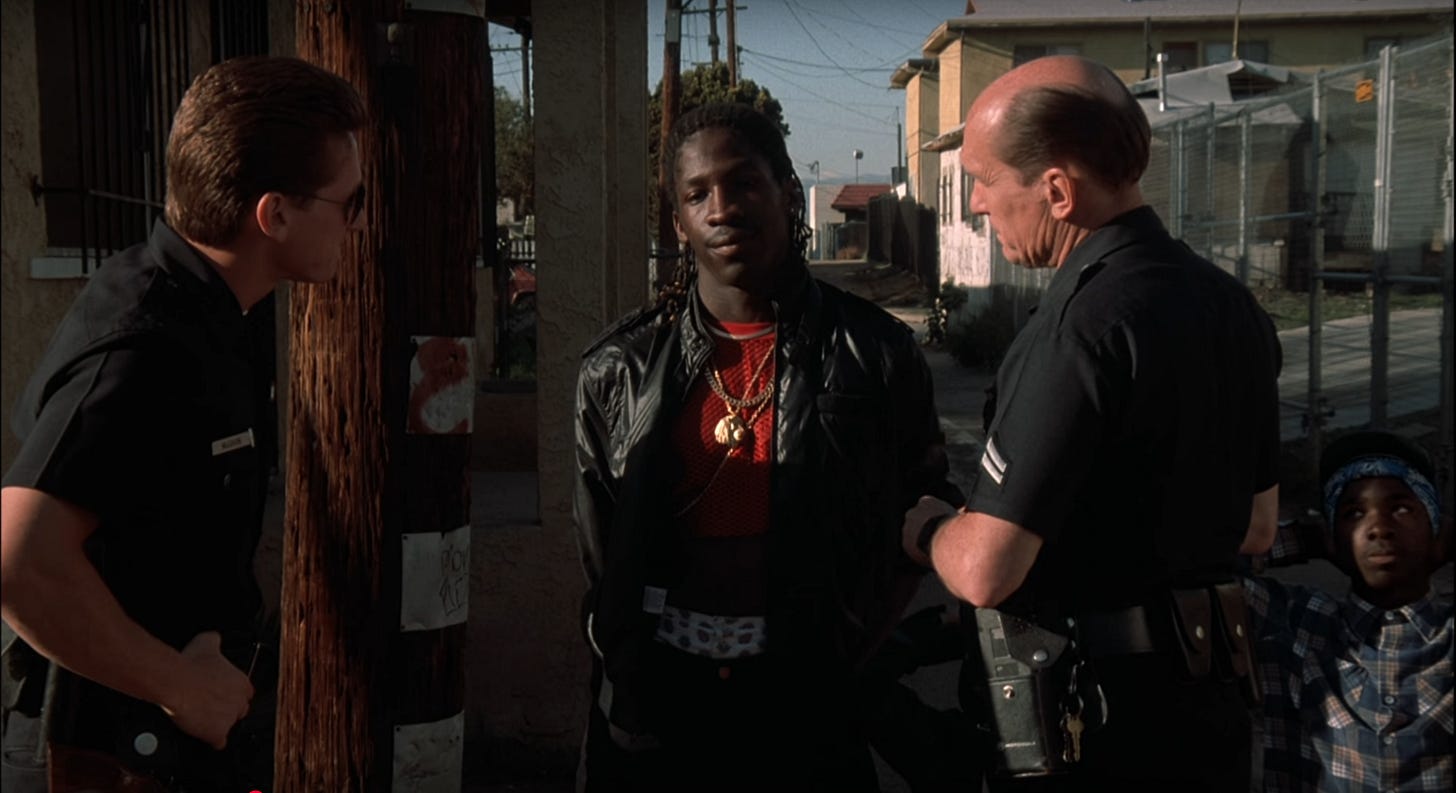
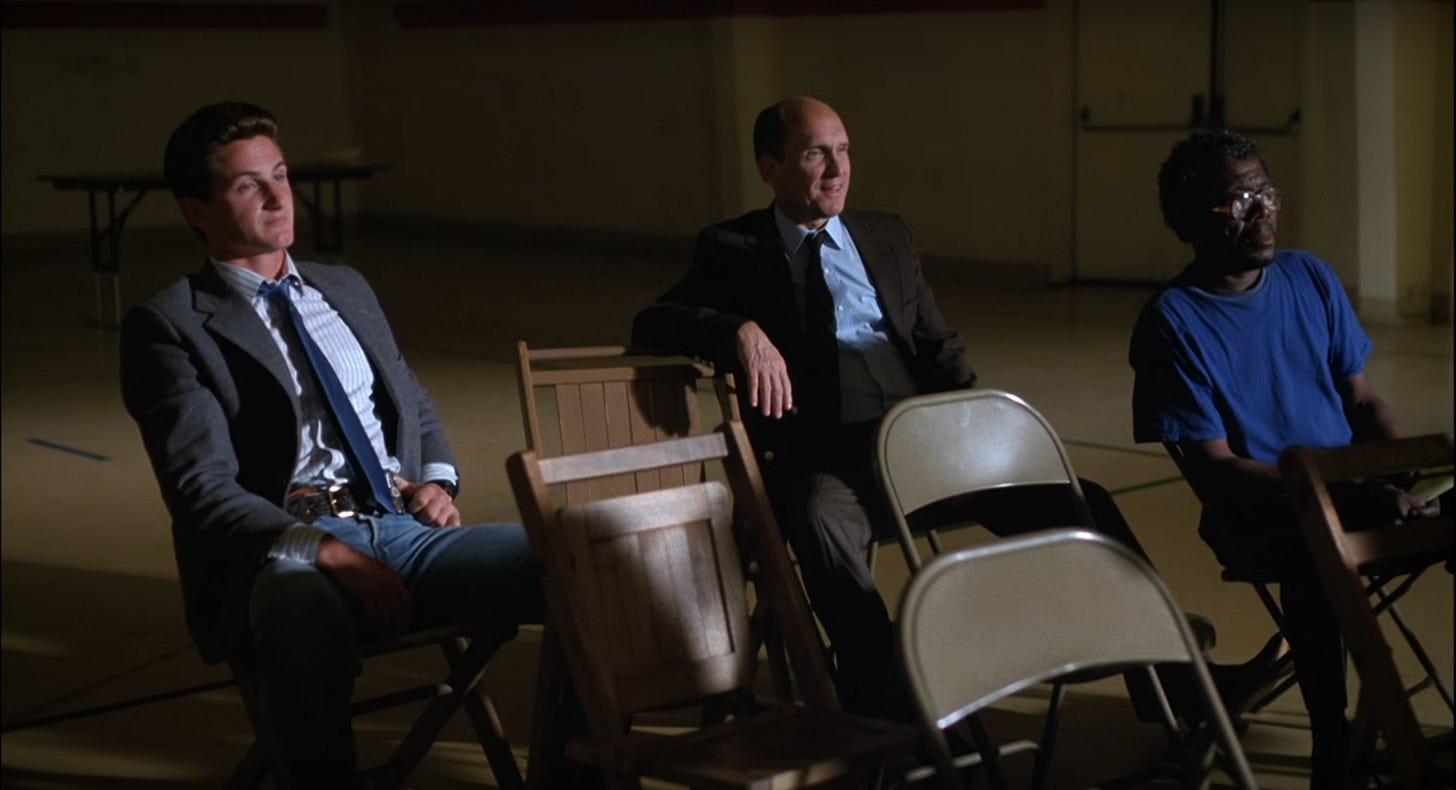
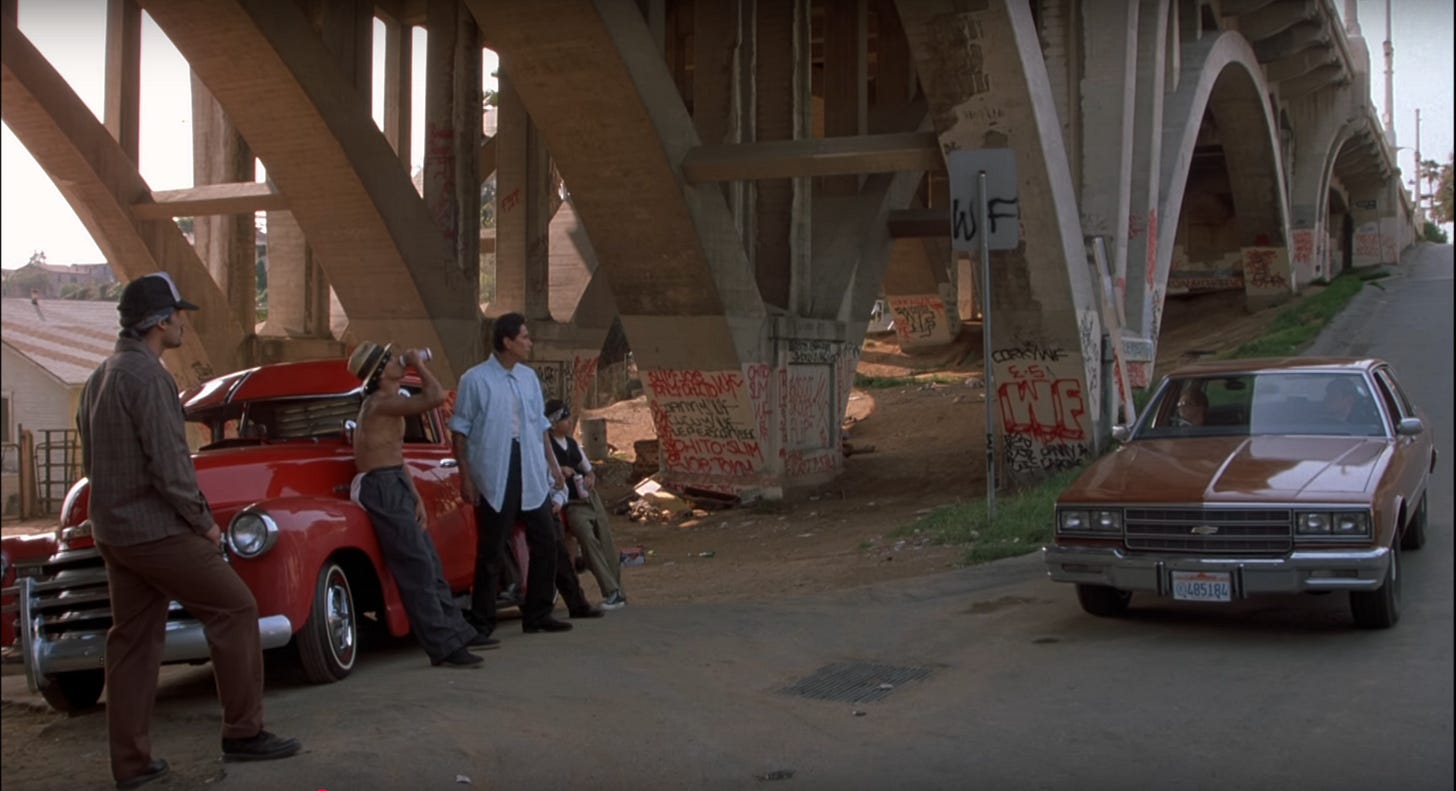
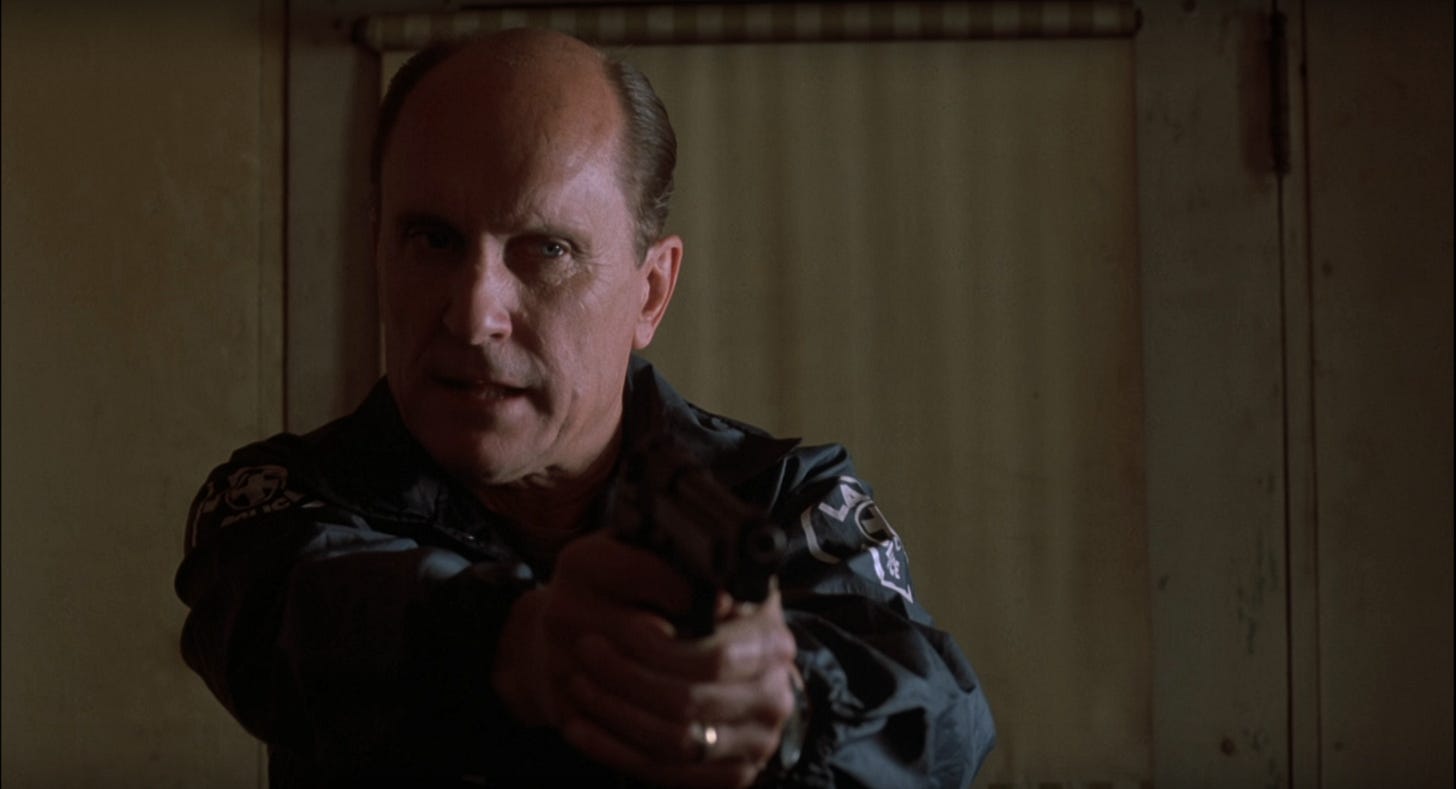
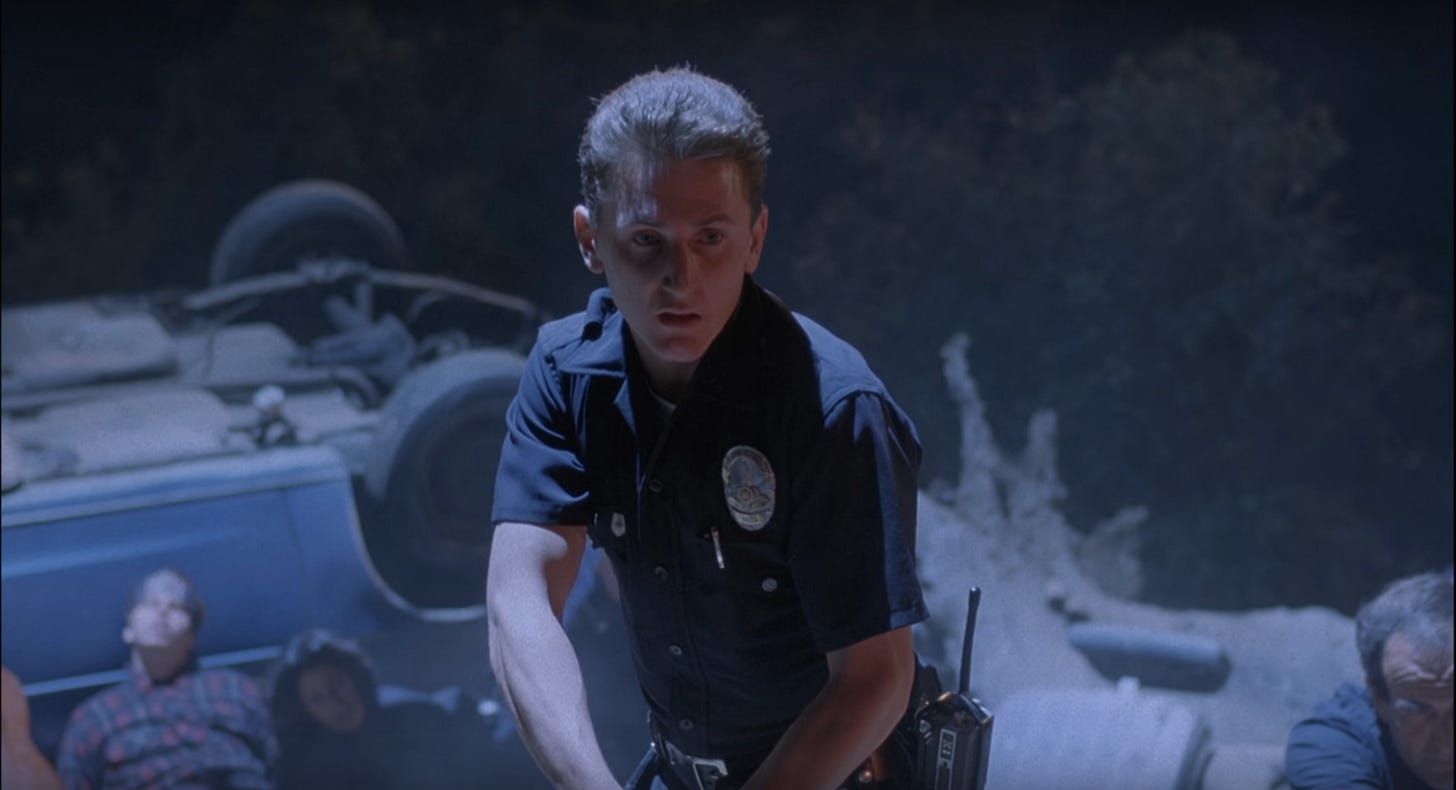


Hey Joe… Thanks for this analysis and review… I loved this movie! The depiction of these guys in these circumstances is way closer to the mark than Hollywood’s usual stereotype derived from consultants or somebody that knows somebody that knows somebody… I grew up in the San Gabriel Valley, in South El Monte, and ran around East LA (specifically Maravilla and City Terrace) playing sports, and being in a band allowed me to interact, at least on the periphery, with a lot of some really dangerous dudes… And when I watched Colors,, I caught myself saying I grew up with that guy, oh shit I know that guy… So, although some of the plot was contrived, it hit home for me and I enjoyed the movie very much. As always great job Joe! Peace! CPZ.